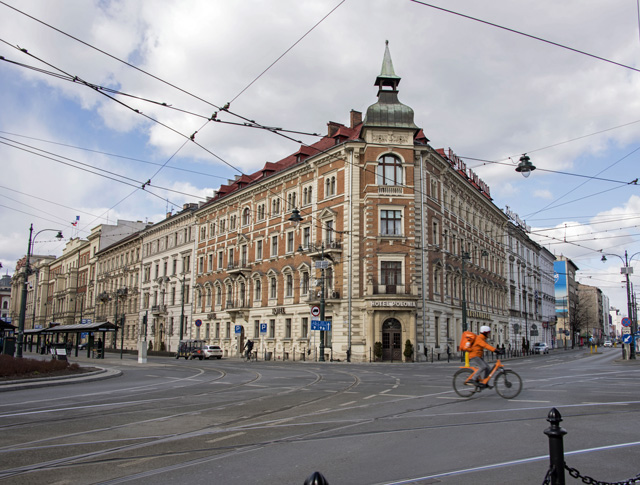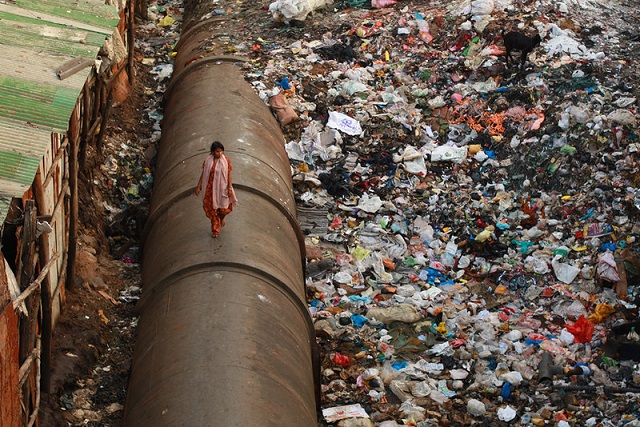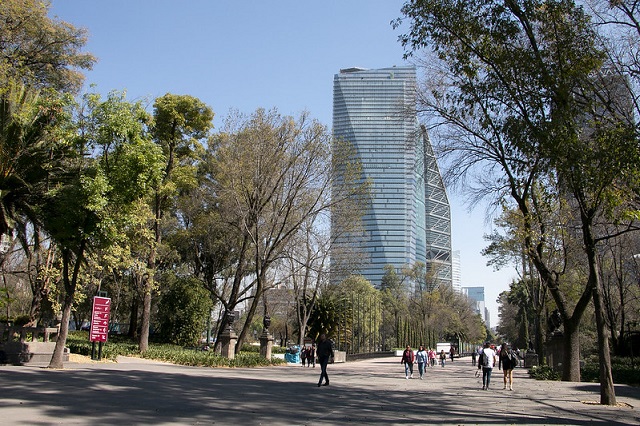
COVID-19 has revived anti-urban sentiments, but the broader global trend of rapid urbanization continues. Photo by iStock
This article was originally published on Global Dashboard, as part of their Scenarios Week series, exploring and expanding on Long Crisis Scenarios.
For professional optimists like me in the business of advancing an alternative, more wholesome economic model, the temptation can be strong to project our dreams of a better world onto the COVID-19 screens where different futures are playing out. These “screens” of course are no blank canvases: rather, stages upon which diverse actors, old and new, motivated by their own designs and pandemic-fueled fantasies are vying for control of the script.
The Long Crisis scenarios are a timely and helpful reminder that nothing is settled: our future is up for grabs. Possibility-laden as this moment is, we must yet grapple with the formidable forces of incumbency pulling us back to the status quo ante. A better future can only be won by equipping and empowering cities to drive a green, inclusive recovery post-COVID-19.
Cities and the Long Scenarios
The Long Crisis scenarios provide a useful framework for understanding the forces at work and how power is shifting. They identify key fault lines along which alternative futures will be contested.
Certainly, the pandemic has opened new spaces of possibility, and it also amplifies pre-existing trends. Two major trends that seem to have accelerated, at least in the early days of the pandemic, are the rise of authoritarianism and the surge of people-powered social movements.
A sobering milestone was reached last year when, for the first time in a century, the autocracies of the world were on track to claim a bigger share of the world economy than all the democracies combined.
The pandemic has been good for autocrats, as Hungary’s Viktor Orbán and the Philippines’ Rodrigo Duterte have shown by successfully invoking sweeping emergency powers to strengthen their grip on power. NATO Secretary General Anders Rasmussen has warned that “Tyranny is once again awakening from its slumber.”
Tugging in the opposite direction, we have seen grassroots social movements gaining strength everywhere and on multiple fronts (climate, race, gender, rights, inequality). 2019 was billed as the “year of people power.” The year kicked off with 5 million women in Kerala forming a 620 km human chain to demand their rights be upheld. It saw a lone protest by a schoolgirl in Sweden morph into a global movement which by September had mobilized 7.6 million people from 185 countries onto the streets in the biggest ever demonstration demanding climate action.
What is notable is not just the numbers mobilized, but the effectiveness of these movements in getting their demands answered and advancing their goals. Protest was powerful, it was effective. The pandemic has not stemmed their momentum, on the contrary: it has sparked new forms of action and new forms of mutual and community activism have emerged.
How we emerge from COVID-19 will depend in large part on what happens in the world’s cities. Cities have a crucial role to play in tipping the scales towards a future that is more collective and decentralized, where power is more diffuse and bottom up.
A Watershed Moment for Cities
Since the pandemic is largely an urban phenomenon – over 95% of cases have been in cities – it is unsurprising that this moment has revived dormant anti-urban sentiments. Old tropes about cities as hotbeds of disease, sites of danger, and decay have resurfaced. Michael Kimmelman of The New York Times has declared that pandemics are anti-urban and asks if cities can survive the pandemic.
Others, like Joel Kotkin, predict that it would speed the “end of the megacity era.” These sentiments are misguided in that they deflect from the bigger picture. There will be no urban regression – urbanization will continue apace. What path cities take going forward is a matter of choice, and that is what deserves our full attention.
The coronavirus has indeed exposed grave problems with our cities. Starting with their extreme fragility. Because cities are the main thoroughfares of our economies and key nodes in our global system, they amplify and spread rather than absorb risks which percolate across tightly interconnected economic, energy, food, water, and health systems. Their startling lack of resilience has much to do also with how unequal they have become.
Almost 70% of city dwellers lack access to reliable core services – water, electricity, transport, and affordable housing. More than 880 million people live in densely packed informal settlements where social distancing is not option. Up to 80% of urban employment in cities across the global south is in the informal sector, often beyond the reach of formal social safety nets and employment protection programs. Informal workers in these sectors are the backbones of urban economies across cities of all types yet they lack the resources to ride out a crisis. Thus inequity is a major driver of systemic vulnerability.
These are not inherent qualities of cities, but consequences of particular choices and paradigms of urban development. Fragility and inequity reflect decades of chronic underinvestment in disaster preparedness and in basic public services that underpin the ability of rapidly growing urban populations to lead productive, healthy lives.
As a case in point, between 2000-2015 the number of urban residents who lack safely managed sanitation increased from 1.9 billion in 2000 to 2.3 billion. Likewise, this pandemic has exposed the chronic underinvestment in disaster preparedness and emergency response capabilities.
As with adaptation to climate change, the economic calculus suggests that investments in preparedness and prevention measures add up to a fraction of the costs of failing to do so. (The World Bank and the WHO published a report last September on pandemic preparedness which estimated the cost of prevention measures at $3.4 billion each year, a trifle compared to the trillions that are now being marshaled to stem its economic impacts.)

To build resilience, infrastructure investments need to engage multiple stakeholders and target vulnerable, poor and marginalized populations. Photo by Meena Kadri/Flickr
The pandemic also reveals another side of cities: their endless inventiveness and adaptability in responding to crisis. Cities are petri dishes not just for communicable diseases, but also for breakthrough solutions, innovations and audacious ideas that can uniquely be nurtured to fruition in the urban cauldron.
Whilst urban environments have vectors for the virus’ spread, the crisis seems to have increased public appetite and political space for bold interventions that can radically transform cities. An unintended consequence of this crisis is that it has shown that radical change to our everyday lives and systems is indeed possible.
The air in many cities is cleaner than it has been in decades due to a dramatic decline in vehicle traffic and factory output. Walking and biking are being adopted as new preferred modes of transport for many. Emergency workers are finding that cycling is the fastest and safest way to get around. More than 130 German cities, Bogotá, Mexico City, dozens of cities in the United States, and more each day are announcing plans to add temporary or permanent protected bike lanes and pedestrian infrastructure.
These modes are not only resilient; they are affordable, promote healthy lifestyles, spur regional economic benefits and are integral to people’s access to public transport.
The moment is not for urban regression, it is ripe for urban transformation.
Why Cities Need to be Put at the Heart of COVID-19 Response and Recovery
Regardless of how the pandemic makes people feel about cities, and notwithstanding micro-trends of reverse-urbanization that have been reported in some parts of the world, the inescapable truth of the matter is that there’s going to be many more of us living in cities; 2.5 billion is the estimate for in the next three decades. Much of that growth (90%) will be in Africa and Asia, where more urban area will be built to accommodate the new inflows than has been built throughout history.
And so there’s no dodging the fact that to prevent a future crisis tipping us into shock we need to change the way our cities are built, run and governed. For the recovery to be green and resilient, you need to build resilience where it is most needed, in the world’s cities.
The pandemic drove home forcefully how we are only as strong as our weakest link, underscoring the need to build resilience in urban environments where the impacts and responses to future pandemics will be most dramatically felt and where responses and recovery measures can be the most potent.
Recognizing and addressing the stark reality of urban inequality is essential for addressing this and future pandemics. Closing the urban services divide can help cities build back better and more equitably to better withstand the next crisis.
A green and resilient recovery for cities is not only economically and socially attractive in the immediate term, it is also key to meeting shared climate and Sustainable Development Goals. As the IPCC Special Report on Global Warming of 1.5°C pointed out, cities – with their concentration of people, economic activity, and infrastructure – are one of the few systems that can be decarbonized and made resilient fast enough to meet Paris goals.
A large portion of the $90 trillion needed in infrastructure investments over the next decade or so will be in cities. Because infrastructure investments are long-lived, failure to make the right choices now will risk locking in dependence on fossil fuels, make the necessary adjustments to forestall climate change more difficult and costly. Thus the fight for a low-carbon, climate resilient future will be won or lost in cities.
Finally, as noted earlier, cities are laboratories of change and drivers of innovation. In Pune, for example, a partnership with informal wastepicker collectives and private companies was integrated into the municipal service infrastructure extending the city’s ability to distribute essential goods. And in Bangalore, a crowd-sourced partnership with a local food delivery platform helped deliver 500,000 meals daily amidst the lockdown.

A green, resilient recovery for cities is not only economically and socially attractive in the immediate term, it is key to meeting shared climate and development goals. Photo by WRI México
Unleashing the Potential of Cities to Drive a Green and Inclusive Recovery
To harness the potential of cities to boost collective and decentralized action to drive a green, inclusive and resilient recovery will require progress on at least three fronts.
First, bold action by national governments is needed to address the massive urban infrastructure gap and close the urban services divide. Many of the policy levers that affect urban change lie beyond the direct authority of cities (e.g. energy, transport, housing policy).
And much of the financing that will influence the shape and development of cities for decades will be mediated through national governments in the massive economic recovery packages that are being pulled together. This is especially true post-COVID-19 as cities that already tend to be highly dependent on fiscal transfers from national government are even more acutely so since the lockdown has devastated local budgets.
As cities shift from crisis response to recovery, engagement with national governments will be key therefore to shaping large-scale investments in infrastructure for water, sanitation, housing/slum upgrading, and transport which are needed to build back better and provide growing urban populations with essential services.
As important as what goes into these packages is the question of how they are put together and rolled out. To build resilience to the next shock, these investments programs will need to effectively engage city stakeholders and target vulnerable, poor and marginalized urban populations. South Africa, where the Treasury is working with other government departments as well as city organisations to develop a cities support program offers a good example of this.
Second is the need to bolster the capacity of city authorities to be effective agents driving positive change and responsible stewards of the commons beyond their borders. This starts with equipping urban leaders and managers with the skills, tools, data and technical assistance they need to chart a new path for urban development, prioritize investments, inspire action and drive transformative change.
It goes much further though. Cities need to gradually pivot from being “takers” to “shapers” of national policies and regulations. They will need to become savvy at using data to develop and execute plans and more effectively target the most vulnerable communities. They will need to become deft at forming or leveraging broader coalitions – including private and informal sectors – to drive innovation in local service provision (we have seen earlier examples of this already happening).
For change to be sustained beyond the political cycle, transparency is needed to track progress and adjust course along the way, and strong mechanisms need to be in place for accountability and public engagement, which brings us to the next point.
Third, grassroots mobilization and civic engagement need to be encouraged and supported as part of revitalizing urban governance. As incubators of decentralized democracy, cities are frontline in answering the democratic regression. It is in cities that democratic politics can be its most vital.
Already we are seeing elements of a more vibrant place-based politics emerge with a flourishing of local experimentation in empowered deliberative democracy around the world, paving the way for a new wave of innovation in urban governance.
We see this in the Pop-Up Think and Do community space for climate and eco-action on Camden high street, that the indefatigable Farhana Yamin set up in response to the Citizens’ Assembly on the climate crisis recommendation to do more to bring existing community groups together to work on tackling the climate crisis. Also, in the experiments in local monies, including the eusko that was launched last year in the French Basque country.
The convergence of AI/big data, digitization and civic tech creates new opportunities for empowered democratic engagement, as we have seen with new start-ups in civic tech such as Fluicity in France, that provides a digital app-based platform for citizen engagement with local government.
All this is important not just for cities: building an engaged citizenry is fundamental to the health of our democracies more generally.
These are among the thousands of bright spots of light that give me faith that the future post-COVID-19, will ultimately be one of greater collective action and a more vibrant decentralized economy.
This article was originally published on Global Dashboard, as part of their Scenarios Week series, exploring and expanding on Long Crisis Scenarios. You can find the other articles in the series on Global Dashboard’s Scenarios Week page.
Leo Horn-Phathanothai is Head of WRI’s London Office and Director for Strategy and Partnerships at WRI Ross Center for Sustainable Cities.








